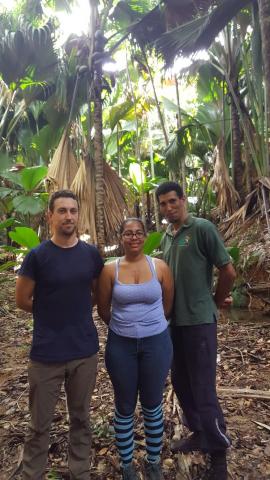
The Seychelles Islands Foundation (SIF) has set up a task force to reduce numbers of the invasive yellow crazy ant, which threatens the unique ecosystem of the Vallée de Mai. The specialised team is made up of 18 SIF staff members who have received training to deploy a new type of bait across the forest to control the ants and reduce the impact to native wildlife.
Yellow crazy ants are considered one of the top 100 worst invasive species in the Global Invasive Species Database and can cause severe damage to native wildlife where they invade. They were first recorded in Seychelles on Mahé around 1962 and rapidly spread to neighbouring islands. SIF has documented the spread of YCA across the Vallée de Mai with grave concern. The ants attack wildlife with their formic acid spray, which can blind animals much larger than the YCA. This makes YCA a formidable threat to other species, and to the fragile palm forest ecosystem. Declines in several endemic animal species have already been observed.
SIF has previously attempted to control the numbers of yellow crazy ants in the forest using boric acid bait systems which attract the ants to a covered bait station that only they can access. However, these have been unsuccessful in reducing YCA abundance or distribution, which now extends across the entire Vallée de Mai. After extensive research and advice from yellow crazy ant experts, the Ministry of Energy, Environment and Climate Change and Seychelles Pesticide Board approved the use of ‘AntOff’, a pesticide contained in granular pellets which is especially designed to combat ants. It is the most successful pesticide used against yellow crazy ants in the world.
The active ingredient in ‘AntOff’ is fipronil, a pesticide which is toxic to ants but is contained in such minuscule quantities (0.001% within each pellet) that it does not a pose a risk to other wildlife in the forest or to humans. The taskforce will be spreading AntOff pellets throughout the forest from 26th August, except in areas near waterways. The pesticide remains active for around six hours before it naturally breaks down. The remaining 99.999% of the bait is composed of fish meal, a paste which has been designed to be extremely attractive to ants. SIF will closely monitor the numbers of ants and other wildlife in the forest in the months following baiting to measure its impact in the Vallée de Mai.
The yellow crazy ant task force is headed up by three team leaders, Senior Ranger Terance Payet, Senior Ranger Shanone Hibonne, and Vallée de Mai Science Coordinator Luke A’Bear. Terance joined the SIF team in 2011; as a research team member he plays a major role in research and monitoring programmes with his vast knowledge of the fauna and flora in the Vallée de Mai. Shanone joined SIF in October 2014. She has been extensively trained in invasive plant control and YCA monitoring techniques and is the longest involved staff member in any of the invasive species research in the Vallée de Mai. Luke recently joined SIF and his experience as senior warden on Round Island in Mauritius, where he was responsible for implementing strict biosecurity control, will be of huge benefit to this project.
Terance Payet said, “The whole Vallée de Mai team is extremely motivated by this next phase in the yellow crazy ant control programme. I’m pleased to work for a proactive organisation such as SIF which is leading the way in tackling this destructive invasive species in Seychelles. We are confident this new tactic will have a significant impact to decrease and control the numbers of yellow crazy ants in the forest and protect its unique endemic wildlife”.






